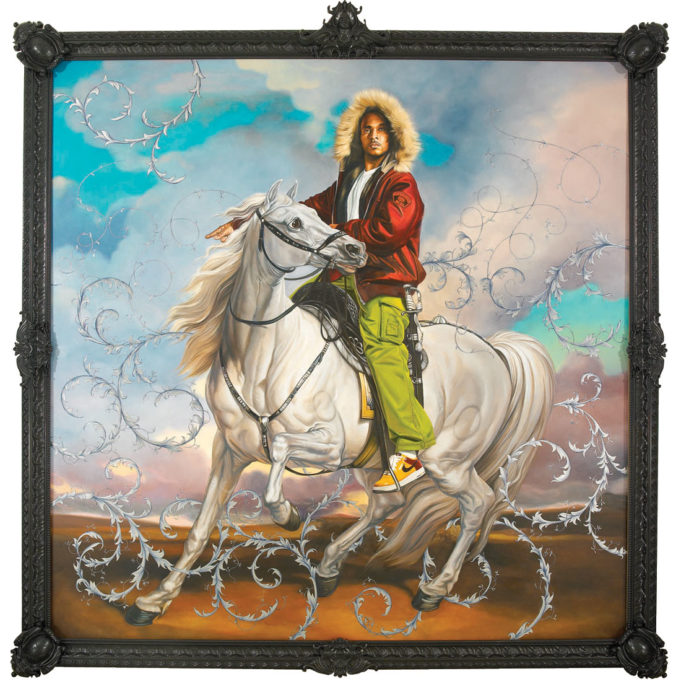In 1849, the painter Gustave Courbet scandalized the French art world with “A Burial at Ornans,” a huge work that depicted an ordinary peasant funeral on a grand scale, the kind usually reserved for celebrating kings, battles, and moments in national history. People at the time thought this was vulgar, ugly, and wrong, which was the reaction Courbet expected. Twenty-first-century America is not 19th-century France, and yet Kehinde Wiley has done something similar in his body of work, largely addressing race rather than class. That’s just one reason to see his retrospective, Kehinde Wiley: A New Republic at the Modern, the most outrageously beautiful museum show that Fort Worth has seen in quite some time.
The exhibit’s main attractions are the paintings that have made Wiley famous. His Rumors of War series is made up of large canvases of handsome young African-American men striking martial poses copied from portraits from Western art that they selected for themselves. (The artist generally finds the men on the street, and the exhibit comes with an indispensable video component showing how he recruits his models.) They’re painted wearing their own clothes but against backgrounds that are often abstracted designs reminiscent of African kente and Dutch batik fabrics, the latter now a symbol of Africa. The synthesis of European foregrounds and African backgrounds reflects the culture that African-Americans live in, a Western culture that subjugated their ancestors and plundered their resources and physical and intellectual labor. Wiley’s paintings could easily tip over into parody, with their tattooed men wearing hip-hop fashions mounted on horses or wielding swords. Instead, these black men look noble, defiant, confident, and in on the artist’s appropriation of dominant white culture for his own ends. It’s easy to admire Wiley’s technical skill. With his brush and oil paint he is able to render the skin tones as well as a whole range of surfaces from the cotton t-shirt worn in “Portrait of a Venetian Ambassador, Aged 59, II” to the glistening armor donned by Michael Jackson (one of Wiley’s few famous subjects) in the “Equestrian Portrait of King Philip II.”
For those who know Wiley from these paintings, the revelation in this show will be his works in other media. His Iconic series puts black men into the poses of medieval Christian icons and depicts them on wooden panels covered in gold leaf, just like those Byzantine works. Instead of huge canvases, these smaller works have a sanctifying effect on its subjects. The same can be said for his stained glass windows, which re-create Ingres’ works in that medium. The windows were made with the help of a workshop in the Czech Republic and not only feature deep colors in the panes surrounding the subjects but also an expert rendition of cloth like the washed-out denim jeans of Mark Shavers (“St. Adelaide”) and the fleece jacket of Kern Alexander (“St. Amelie”).
None of these, however, is more spectacular than the bronze sculpture called “Bound,” a massive work depicting the bust of the same woman three times, with their hair intertwined in a form suggestive of a giant flowering vine, complete with pieces of foliage. Hair is a big part of black identity, and his rendition of it recalls his early painting “Conspicuous Fraud Series #1 (Eminence),” which is also in the show.
Depicting women is something that Wiley has only recently begun to do, which is why those paintings are hung in two galleries of the Modern. His series An Economy of Grace has background patterns inspired by the textiles of the 19th-century English designer William Morris, which is appropriate considering that English paintings serve as the series’ inspiration. As opposed to the men, the women are wearing diaphanous silk garments specially made for them by Riccardo Tisci, the head designer of Givenchy, along with crushy belts and sizable wigs mimicking the fashions of the sitters in the original Victorian works. Both here and in The World Stage: Jamaica, which also depicts women, Wiley refuses to reduce his subjects to mere objects of our gaze. Instead, they coolly look out at the viewer (as in “Naomi and Her Daughters,” which eschews the despair in the original George Dawe painting) or turn entirely away (as in “Princess Victoire of Saxe-Coburg-Gotha,” inspired by Edwin Landseer’s portrait).
Wiley does not exclusively paint African-American subjects. The exhibit contains works from his World Stage series, in which he traveled to various countries to find models. His “The White Slave” is a patch of Lecomte de Nouÿ’s orientalist 19th-century painting, but the Frenchman’s fleshy, nearly naked white woman has been replaced by a slender South Asian man wearing an L.A. Lakers shirt and sitting in the lotus position, looking like a commanding presence. These series take their cues from everything from Chinese social-realist paintings to African wood sculpture.
Still, his work remains centered around the African-American experience. These days, everything from daily news reports to Ta-Nehisi Coates’ latest book reminds us of our nation’s long and sordid history of using young black bodies as canvases for violence. Wiley’s art points a new way, showing us those same bodies as canvases for beauty, dignity, and grace. At a time when so much of society continues to see young black men as threats, young black women as sex objects, and young black people as disposable, Wiley demands that we look at them differently. Who’s to say that these men with cornrows or dreadlocks, low-rise jeans, and bling don’t deserve to be memorialized in these artworks that write their innate humanity large? That’s the question the Modern’s exhibit puts squarely to us, and it needs to be heard especially urgently now.
[box_info]Kehinde Wiley:
A New Republic
Thru Jan 10. Modern Art Museum of Fort Worth,
3200 Darnell St, FW. $4-10. 817-738-9215.[/box_info]












